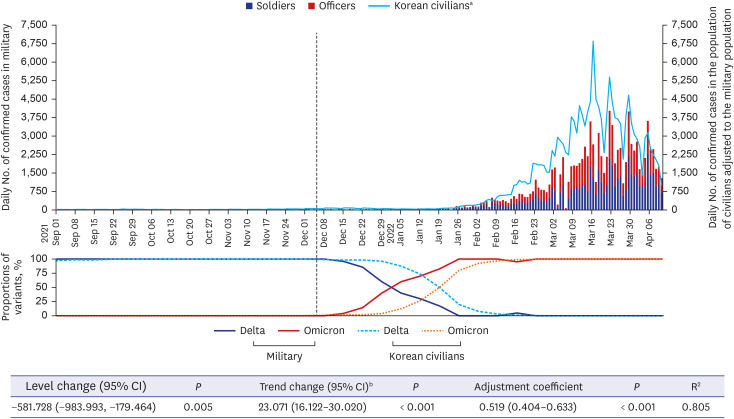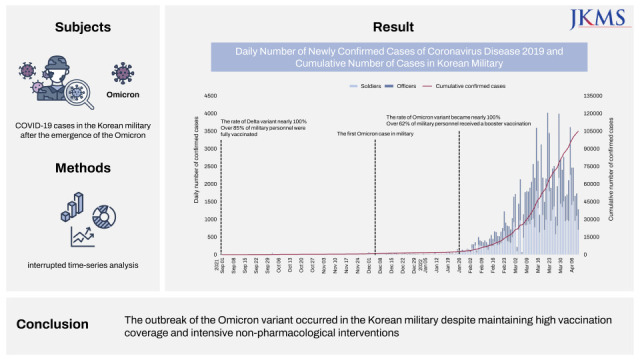2. Karim SS, Karim QA. Omicron SARS-CoV-2 variant: a new chapter in the COVID-19 pandemic. Lancet. 2021; 398(10317):2126–2128. PMID:
34871545.

3. Hu J, Peng P, Cao X, Wu K, Chen J, Wang K, et al. Increased immune escape of the new SARS-CoV-2 variant of concern Omicron. Cell Mol Immunol. 2022; 19(2):293–295. PMID:
35017716.

4. Ritchie H, Mathieu E, Rodés-Guirao L, Appel C, Giattino C, Ortiz-Ospina E, et al. Coronavirus pandemic (COVID-19). Updated 2022. Accessed May 23, 2022.
https://ourworldindata.org/coronavirus
.
5. Shin DH, Oh HS, Jang H, Lee S, Choi BS, Kim D. Analyses of confirmed COVID-19 cases among Korean military personnel after mass vaccination. J Korean Med Sci. 2022; 37(3):e23. PMID:
35040298.

7. Tartof SY, Slezak JM, Fischer H, Hong V, Ackerson BK, Ranasinghe ON, et al. Effectiveness of mRNA BNT162b2 COVID-19 vaccine up to 6 months in a large integrated health system in the USA: a retrospective cohort study. Lancet. 2021; 398(10309):1407–1416. PMID:
34619098.

9. Hartmann DP, Gottman JM, Jones RR, Gardner W, Kazdin AE, Vaught RS. Interrupted time-series analysis and its application to behavioral data. J Appl Behav Anal. 1980; 13(4):543–559. PMID:
16795632.

10. Nordström P, Ballin M, Nordström A. Risk of infection, hospitalisation, and death up to 9 months after a second dose of COVID-19 vaccine: a retrospective, total population cohort study in Sweden. Lancet. 2022; 399(10327):814–823. PMID:
35131043.

11. Nyberg T, Ferguson NM, Nash SG, Webster HH, Flaxman S, Andrews N, et al. Comparative analysis of the risks of hospitalisation and death associated with SARS-CoV-2 omicron (B.1.1.529) and delta (B.1.617.2) variants in England: a cohort study. Lancet. 2022; 399(10332):1303–1312. PMID:
35305296.

12. Jung F, Krieger V, Hufert FT, Küpper JH. Herd immunity or suppression strategy to combat COVID-19. Clin Hemorheol Microcirc. 2020; 75(1):13–17. PMID:
32538831.

13. Andrews N, Stowe J, Kirsebom F, Toffa S, Rickeard T, Gallagher E, et al. Covid-19 vaccine effectiveness against the Omicron (B. 1.1. 529) variant. N Engl J Med. 2022; 386(16):1532–1546. PMID:
35249272.

14. MacIntyre CR, Costantino V, Trent M. Modelling of COVID-19 vaccination strategies and herd immunity, in scenarios of limited and full vaccine supply in NSW, Australia. Vaccine. 2022; 40(17):2506–2513. PMID:
33958223.

15. Altarawneh HN, Chemaitelly H, Ayoub HH, Tang P, Hasan MR, Yassine HM, et al. Effects of previous infection and vaccination on symptomatic Omicron infections. N Engl J Med. 2022; 387(1):21–34. PMID:
35704396.

16. Khandia R, Singhal S, Alqahtani T, Kamal MA, El-Shall NA, Nainu F, et al. Emergence of SARS-CoV-2 Omicron (B.1.1.529) variant, salient features, high global health concerns and strategies to counter it amid ongoing COVID-19 pandemic. Environ Res. 2022; 209:112816. PMID:
35093310.

17. Skegg DC, Hill PC. Defining covid-19 elimination. BMJ. 2021; 374:n1794. PMID:
34266880.

18. Emanuel EJ, Osterholm M, Gounder CR. A national strategy for the “New Normal” of life with COVID. JAMA. 2022; 327(3):211–212. PMID:
34989789.

19. Marcus JE, Frankel DN, Pawlak MT, Casey TM, Cybulski RJ Jr, Enriquez E, et al. Risk factors associated with COVID-19 transmission among US air force trainees in a congregant setting. JAMA Netw Open. 2021; 4(2):e210202. PMID:
33630090.
20. Baettig SJ, Parini A, Cardona I, Morand GB. Case series of coronavirus (SARS-CoV-2) in a military recruit school: clinical, sanitary and logistical implications. BMJ Mil Health. 2021; 167(4):251–254.

21. Kim C, Kim YM, Heo N, Park E, Choi S, Kim N, et al. COVID-19 outbreak in a military unit in Korea. Epidemiol Health. 2021; 43:e2021065.







 PDF
PDF Citation
Citation Print
Print




 XML Download
XML Download